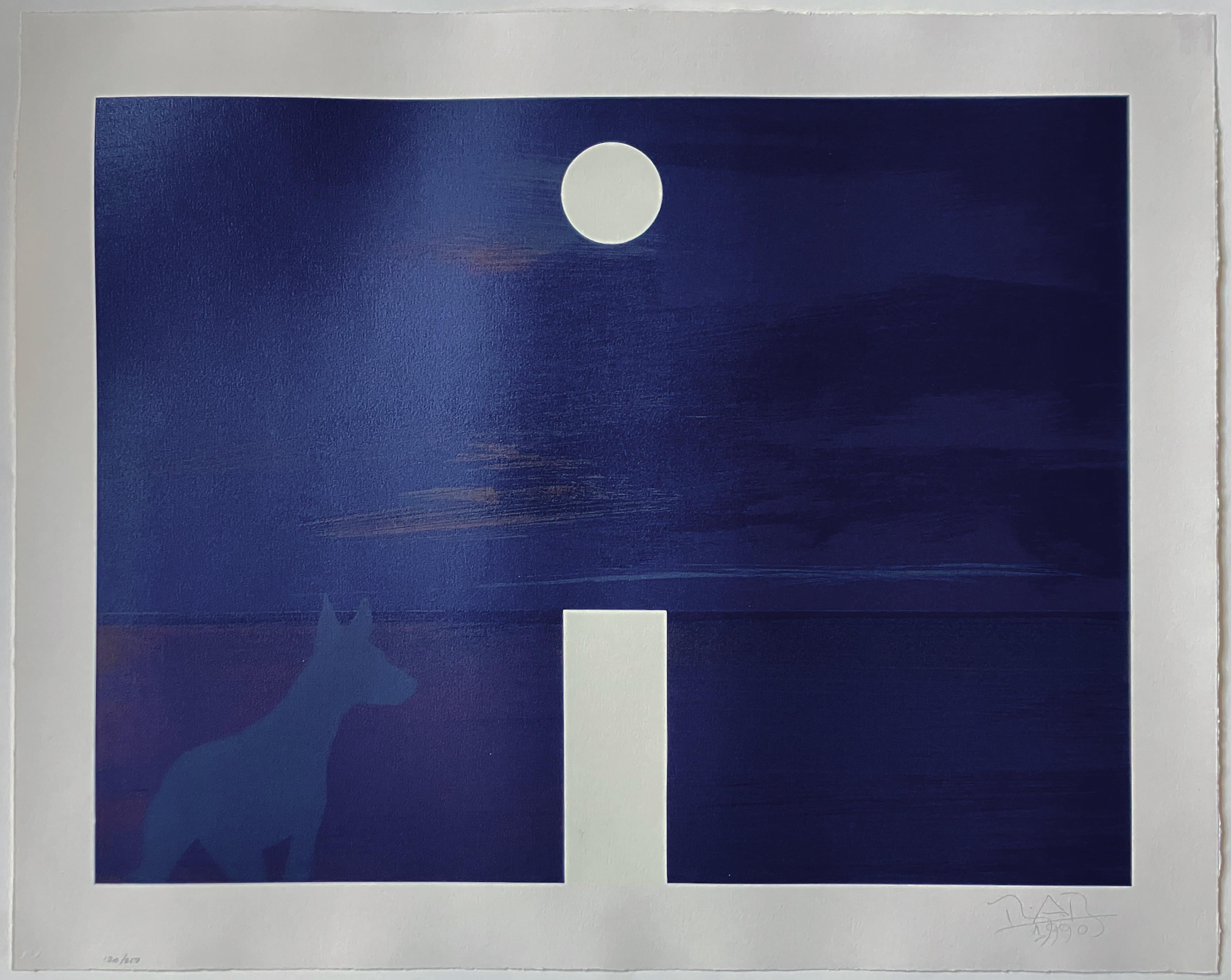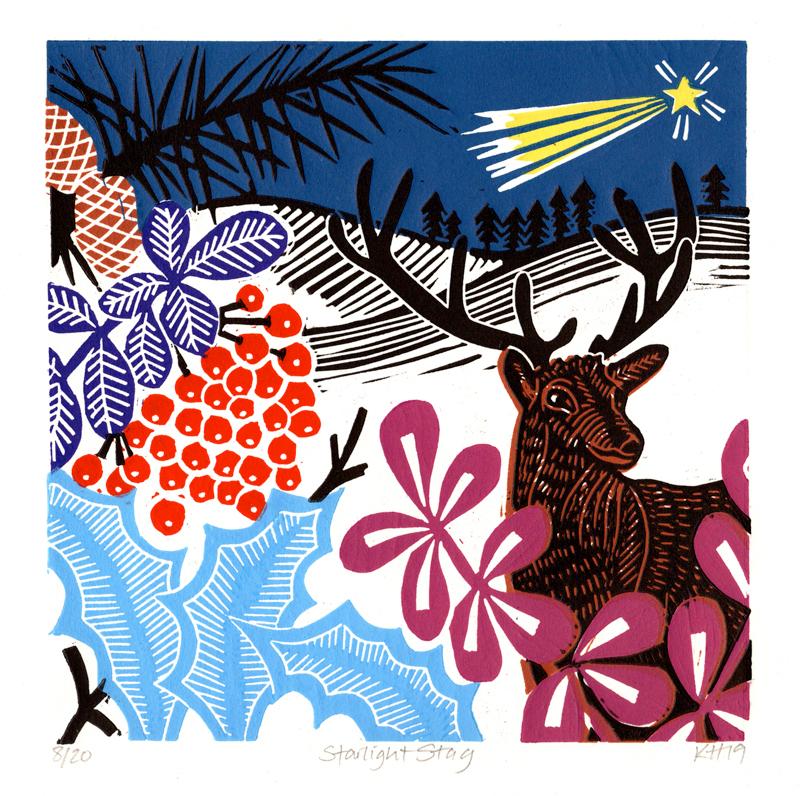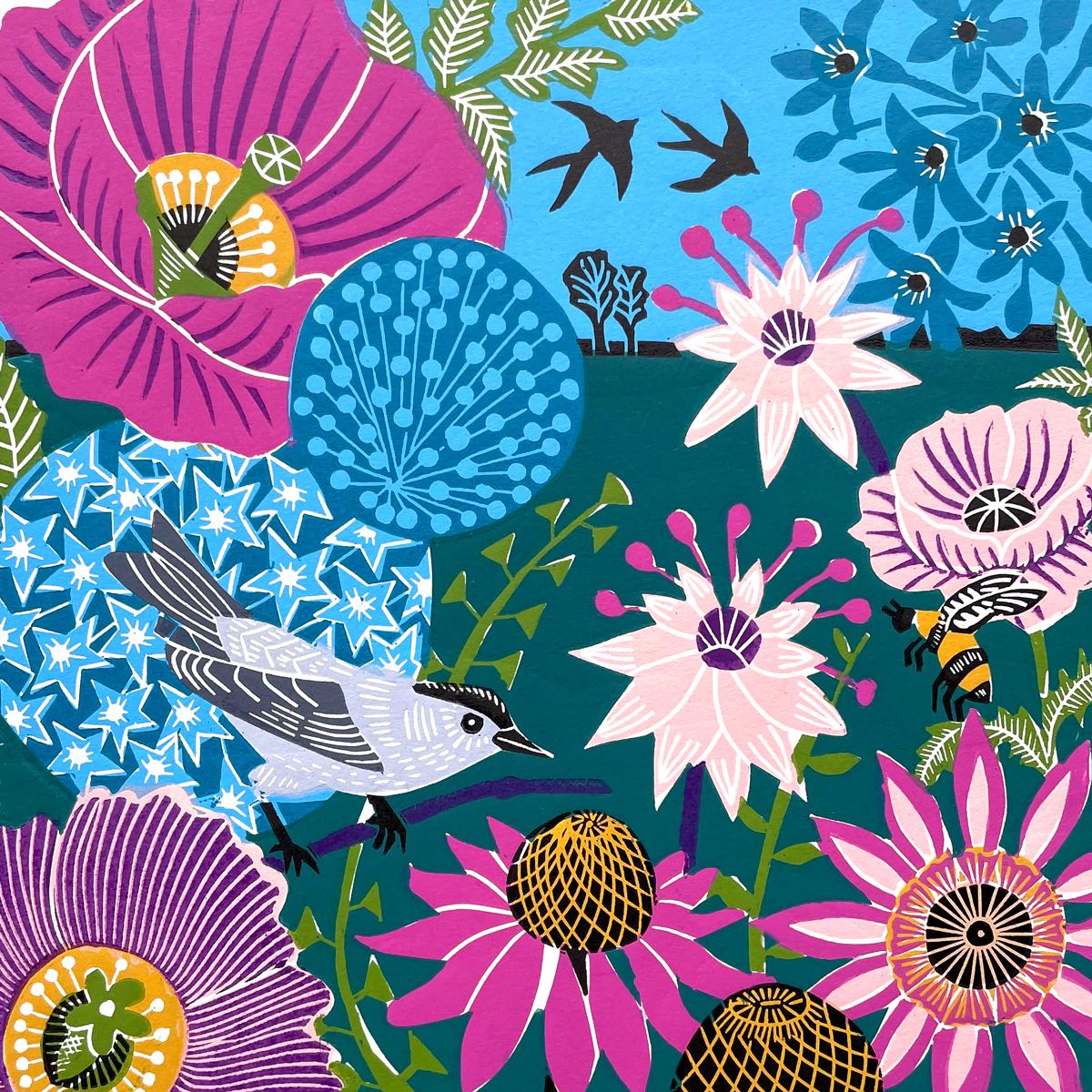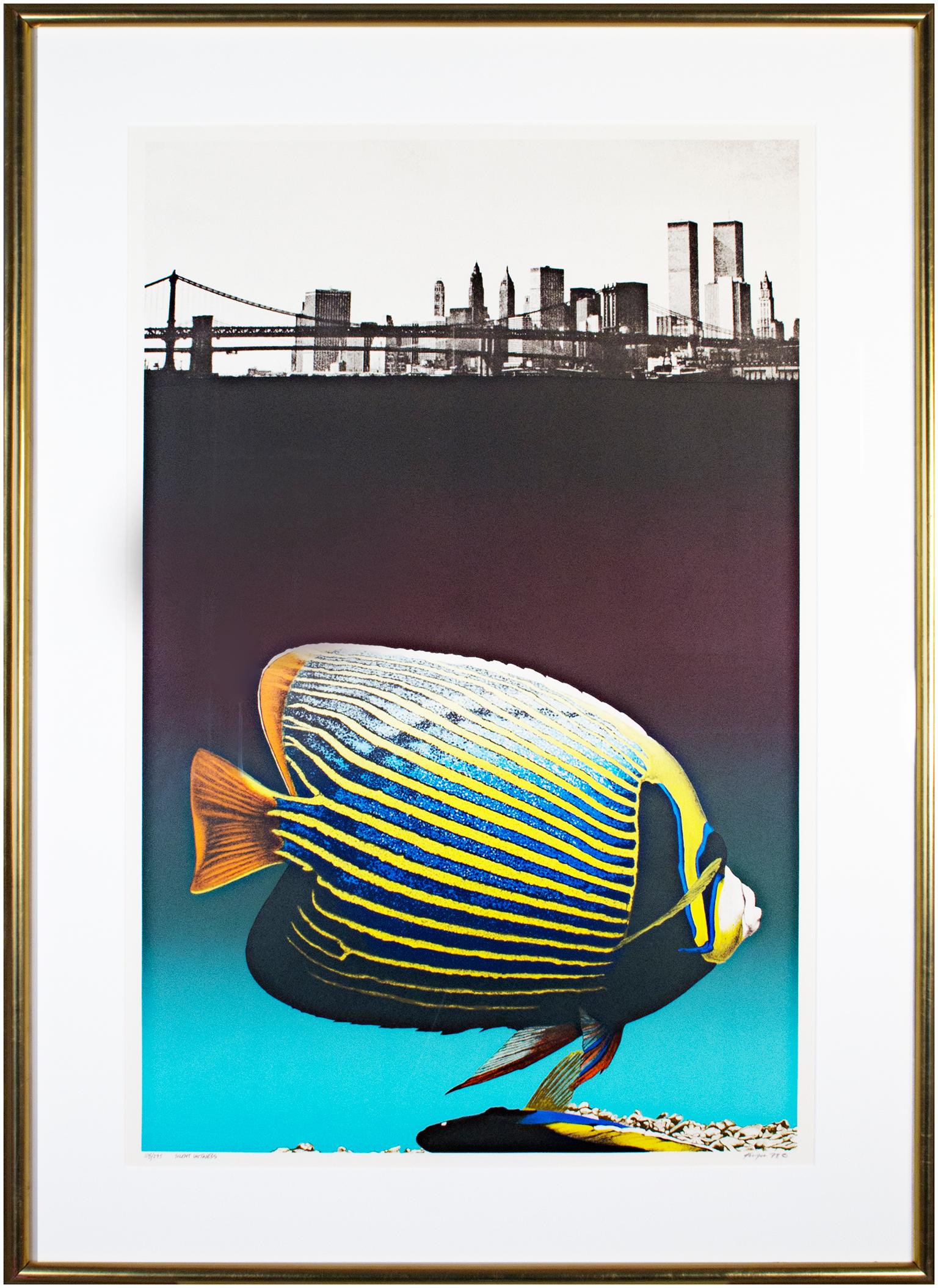Items Similar to Hurry Sundown
Want more images or videos?
Request additional images or videos from the seller
Billy SchenckHurry Sundown1985
1985
About the Item
Billy Schenck (American, b. 1947)
Hurry Sundown, 1985
Edition 19/60
Serigraph
21 x 38 inches
Signed, Titled, Dated, and Numbered Lower Margin
Billy Schenck is a contemporary artist with work in over 40 museum collections and corporate collections that include Sony, IBM, Saatchi and Saatchi, American Airlines and others. His subject matter spans genres from western landscape to cowboy pop. He has been exhibited widely in the United States and Europe. He is a World Champion Ranch Sorting winner and the proprietor of the Double Standard Ranch in Santa Fe, New Mexico, his home for the past two decades.
- Creator:Billy Schenck (1947, American)
- Creation Year:1985
- Dimensions:Height: 21 in (53.34 cm)Width: 38 in (96.52 cm)Depth: 1 in (2.54 cm)
- Medium:
- Movement & Style:
- Period:
- Condition:
- Gallery Location:Missouri, MO
- Reference Number:1stDibs: LU74737660862
Billy Schenck
Billy Schenck has been known internationally for 44 years as one of the originators of the contemporary 'Pop' western art movement. He is an American painter who incorporates techniques from Photo-Realism with a Pop Art sensibility to both exalt and poke fun at images of the West. Schenck has had over 100 solo shows. His work is in the permanent collections of 48 museums and important private and corporate collections. Museum collections include the Smithsonian, Mesa Southwest Museum, The Tucson Museum of Art, The Denver Art Museum, Museum of the Southwest, Midland TX, Albuquerque Fine Arts Museum and the New Mexico Museum of Art. Private collections include the estate of Malcolm Forbes, Steve Forbes, Chris Evert, Elaine Horwitch, Louis Meisel, Martina Navratilova, Laurance Rockefeller, Fritz Scholder and Sylvester Stallone. Corporate collections include: American Airlines, I.B.M., Raymond James Financial, Wells Fargo Bank, Hilton Hotels, Sturm Ruger and The National Bank of Switzerland. “What has remained constant throughout Schenck’s career is his individuality in dealing with the subject matter of the west. Using the artistic formula of classic western film direction and the photographically reliant systems of contemporary art, he has bridged two genres that resonate with the American experience. From early depictions of cinematic cowboys to real-life cowboys and cowgirls to poetic reveries about the Native American existence in the Southwest, Schenck melds the real with the imagined, autobiography with fantasy.” -Julie Sasse, Chief Curator and Curator of Modern and Contemporary Art, Tucson Museum of Art.
About the Seller
5.0
Vetted Seller
These experienced sellers undergo a comprehensive evaluation by our team of in-house experts.
Established in 1970
1stDibs seller since 2017
141 sales on 1stDibs
Typical response time: 22 hours
- ShippingRetrieving quote...Ships From: Missouri, MO
- Return PolicyA return for this item may be initiated within 2 days of delivery.
More From This SellerView All
- Herring GullsBy Jamie WyethLocated in Missouri, MOJamie Wyeth "Herring Gulls" 1978 Color Lithograph Signed Lower Right Numbered Lower Left 149/300 Born in 1946, James Browning Wyeth came of age when the meaning of patriotism was clouded by the traumas of the Vietnam War and the scandals of Watergate. Working in an era of turmoil and questioning of governmental authority, he did art that encompassed both marching off to war and marching in protest. One of James's early masterworks, Draft Age (1965) depicts a childhood friend as a defiant Vietnam-era teenager resplendent in dark sunglasses and black leather jacket in a suitably insouciant pose. Two years later Wyeth painstakingly composed a haunting, posthumous Portrait of President John F. Kennedy (1967) that seems to catch the martyred Chief Executive in a moment of agonized indecision. As Wyeth Center curator Lauren Raye Smith points out, Wyeth "did not deify the slain president, [but] on the contrary made him seem almost too human." Based on hours of study and sketching of JFK's brothers Robert and Edward - documented by insightful studies in the exhibition - the final, pensive portrait seemed too realistic to family members and friends. "His brother Robert," writes Smith in the exhibition catalogue, "reportedly felt uneasy about this depiction, and said it reminded him of the President during the Bay of Pigs invasion." In spite of these misgivings, James's JFK likeness has been reproduced frequently and is one of the highlights of this show. The poignancy, appeal and perceptiveness of this portrait, painted when the youngest Wyeth was 21 years old, makes one wish he would do more portraits of important public figures. James himself feels he is at his best painting people he knows well, as exemplified by his vibrant Portrait of Jean Kennedy Smith (1972), which captures the vitality of the slain President's handsome sister. He did paint a portrait of Jimmy Carter for the January 1977 man-of-the-year cover of Time magazine, showing the casually dressed President-elect as a straightforward character posed under a flag-draped water tower next to the family peanut plant in Plains, Ga. James recalls that Carter had one Secret Service agent guarding him as he posed outdoors, a far cry from the protection our Chief Executives require today. As a participating artist in the "Eyewitness to Space" program organized by the National Aeronautics and Space Administration in collaboration with the National Gallery of Art in the late 1960s, Wyeth deftly recorded in a series of watercolors his eyewitness observations of dramatic spacecraft launchings and more mundane scenes associated with the space program. Commissioned by Harper's Magazine to cover the 1974 congressional hearings and trials of Watergate figures, James Wyeth executed a series of perceptive and now evocative sketches that recall those dark chapters in our history. Memorable images include a scowling John Ehrlichman, a hollow-eyed Bob Haldeman, an owlish Charles Colson, a focused Congressman Peter Rodino, a grim visaged Father/ Congressman Robert Drinan, and vignettes of the press and various courtroom activities. An 11-by-14-inch pencil sketch of the unflappable Judge John Sirica is especially well done. These "images are powerful as historical records," observes Smith, "and as lyrically journalistic impressions of events that changed the nation forever." Wyeth's sketch of early-morning crowds lined up outside the Supreme Court building hoping to hear the Watergate case, with the ubiquitous TV cameramen looking on, is reminiscent of recent scenes as the high court grappled with the Bush-Gore contest. The Wyeth family penchant for whimsy and enigmatic images is evident in Islanders (1990), showing two of James's friends, wearing goofy hats, sitting on the porch of a small Monhegan Island (Me.) cottage draped with a large American flag. Mixing the serious symbolism of Old Glory with the irreverent appearance of the two men, James has created a puzzling but interesting composition. Painting White House...Category
1970s American Modern Animal Prints
MaterialsPaper, Lithograph
- One of Their Pets (Two Farm Boys and Cow at the Watering Hole)By Joseph VorstLocated in Missouri, MOOne of Their Pets (Two Farm Boys and Cow at The Watering Hole) By Joseph Vorst (1897-1947) Signed Lower Right Edition 1/50 Lower Left Unframed: 8.5" x 11" Framed: 16" x 18.5" German-born Joseph Vorst came from Essen (born June 19, 1897). His teacher was the leading German impressionist Max Liebermann (1847-1935), who was the champion of French impressionism in Berlin. He had traveled to Barbizon and Paris to see paintings by Manet first hand, including In the Conservatory, which made its way to Berlin. Later Vorst's home town of Essen would acquire a collection of modern art in 1921, which became the Museum Folkwang, one of the earliest of its kind. Most likely to escape the Nazis, Vorst made his way to Missouri; we know that he was a member of the American Artists Congress and he signed the famous "Call" in 1936 at the group's first congress, the left-wing organization that stood up to combat fascism. Surely he would have known Joe Jones...Category
Early 20th Century American Realist Landscape Prints
MaterialsLithograph
- Bird's Eye ViewBy Ronnie CutroneLocated in Missouri, MORonnie Cutrone (1948-2013) "Bird's Eye View" c. 1980s Color Lithograph Ed. 222/250 Signed, Numbered and Titled Image Size: 17 x 23.5 inches Framed Size: approx. 24 x 30 inches. Ronnie Cutrone, a figurehead of the Pop and Post-Pop art scenes, was Andy Warhol's assistant at the Factory atop the Decker Building from 1972-1980, and worked closely with Roy Lichtenstein, combining stylistic elements of both. Cutrone's large-scale paintings of American cartoon icons, like Mickey Mouse, Felix the Cat, and Woody Woodpecker further reinvented kitsch and popular media in terms of fine art. Executed in fluorescent monochromatic colors with the finesse of mass-produced silkscreen and prints, Cutrone's works are the reverse of tromp-l'oeil; they use fine art media (watercolor, pastel, crayon - on high-quality paper) to celebrate, rather than hide, the artifice of their subjects. "Everything is cartoon for me", Cutrone is noted for saying, even "ancient manuscripts...Category
Late 20th Century Pop Art Figurative Prints
MaterialsLithograph
- Nasiterna BruijniBy John GouldLocated in Missouri, MOJohn Gould (British, 1804-1881) Nasiterna Bruijni c. 1849-1861 Hand Colored Lithograph Image Size: approx 19.5 x 13.5 inches Framed Size: 27 3/8 x 21 1/2 inches John Gould was an English ornithologist and bird artist. The Gould League in Australia was named after him. His identification of the birds now nicknamed "Darwin's finches" played a role in the inception of Darwin's theory of evolution by natural selection. Gould's work is referenced in Charles Darwin's book, On the Origin of Species. Gould was born in Lyme Regis, Dorset, the son of a gardener, and the boy probably had a scanty education. Shortly afterwards his father obtained a position on an estate near Guildford, Surrey, and then in 1818 became foreman in the Royal Gardens of Windsor. He was for some time under the care of J T Aiton, of the Royal Gardens of Windsor. The young Gould started training as a gardener, being employed under his father at Windsor from 1818 to 1824, and he was subsequently a gardener at Ripley Castle in Yorkshire. He became an expert in the art of taxidermy, and in 1824 he set himself up in business in London as a taxidermist, and his skill led to him becoming the first Curator and Preserver at the museum of the Zoological Society of London in 1827. Gould's position brought him into contact with the country's leading naturalists, and also meant that he was often the first to see new collections of birds given to the Society. In 1830 a collection of birds arrived from the Himalayas, many not previously described. Gould published these birds in A Century of Birds from the Himalaya Mountains (1830-1832). The text was by Nicholas Aylward Vigors, and the illustrations were lithographed by Gould's wife Elizabeth, daughter of Nicholas Coxen of Kent. This work was followed by four more in the next seven years including Birds of Europe in five volumes - completed in 1837, with the text written by Gould himself, edited by his clerk Edwin Prince. Some of the illustrations were made by Edward Lear as part of his Illustrations of the Family of Psittacidae in 1832. Lear however was in financial difficulty, and he sold the entire set of lithographs to Gould. The books were published in a very large size, imperial folio, with magnificent coloured plates. Eventually 41 of these volumes were published with about 3000 plates. They appeared in parts at £3 3s. a number, subscribed for in advance, and in spite of the heavy expense of preparing the plates, Gould succeeded in making his ventures pay and in realizing a fortune. In 1838 he and his wife moved to Australia to work on the Birds of Australia and shortly after his return to England, his wife died in 1841. When Charles Darwin presented his mammal and bird specimens collected during the second voyage of HMS Beagle to the Geological Society of London at their meeting on 4 January 1837, the bird specimens were given to Gould for identification. He set aside his paying work and at the next meeting on 10 January reported that birds from the Galápagos Islands, which Darwin had thought were blackbirds, "gross-bills" and finches were in fact "a series of ground Finches which are so peculiar" as to form "an entirely new group, containing 12 species." This story made the newspapers. In March, Darwin met Gould again, learning that his Galápagos "wren" was another species of finch and the mockingbirds he had labeled by island were separate species rather than just varieties, with relatives on the South American mainland. Subsequently Gould advised that the smaller southern Rhea specimen that had been rescued from a Christmas dinner...Category
1850s Naturalistic Animal Prints
MaterialsLithograph
- Nasiterna PygmaeBy John GouldLocated in Missouri, MOJohn Gould (British, 1804-1881) Nasiterna Pygmae c. 1849-1861 Hand Colored Lithograph Image Size: approx 19.5 x 13.5 inches Framed Size: 27 3/8 x 21 1/2 inches John Gould was an English ornithologist and bird artist. The Gould League in Australia was named after him. His identification of the birds now nicknamed "Darwin's finches" played a role in the inception of Darwin's theory of evolution by natural selection. Gould's work is referenced in Charles Darwin's book, On the Origin of Species. Gould was born in Lyme Regis, Dorset, the son of a gardener, and the boy probably had a scanty education. Shortly afterwards his father obtained a position on an estate near Guildford, Surrey, and then in 1818 became foreman in the Royal Gardens of Windsor. He was for some time under the care of J T Aiton, of the Royal Gardens of Windsor. The young Gould started training as a gardener, being employed under his father at Windsor from 1818 to 1824, and he was subsequently a gardener at Ripley Castle in Yorkshire. He became an expert in the art of taxidermy, and in 1824 he set himself up in business in London as a taxidermist, and his skill led to him becoming the first Curator and Preserver at the museum of the Zoological Society of London in 1827. Gould's position brought him into contact with the country's leading naturalists, and also meant that he was often the first to see new collections of birds given to the Society. In 1830 a collection of birds arrived from the Himalayas, many not previously described. Gould published these birds in A Century of Birds from the Himalaya Mountains (1830-1832). The text was by Nicholas Aylward Vigors, and the illustrations were lithographed by Gould's wife Elizabeth, daughter of Nicholas Coxen of Kent. This work was followed by four more in the next seven years including Birds of Europe in five volumes - completed in 1837, with the text written by Gould himself, edited by his clerk Edwin Prince. Some of the illustrations were made by Edward Lear as part of his Illustrations of the Family of Psittacidae in 1832. Lear however was in financial difficulty, and he sold the entire set of lithographs to Gould. The books were published in a very large size, imperial folio, with magnificent coloured plates. Eventually 41 of these volumes were published with about 3000 plates. They appeared in parts at £3 3s. a number, subscribed for in advance, and in spite of the heavy expense of preparing the plates, Gould succeeded in making his ventures pay and in realizing a fortune. In 1838 he and his wife moved to Australia to work on the Birds of Australia and shortly after his return to England, his wife died in 1841. When Charles Darwin presented his mammal and bird specimens collected during the second voyage of HMS Beagle to the Geological Society of London at their meeting on 4 January 1837, the bird specimens were given to Gould for identification. He set aside his paying work and at the next meeting on 10 January reported that birds from the Galápagos Islands, which Darwin had thought were blackbirds, "gross-bills" and finches were in fact "a series of ground Finches which are so peculiar" as to form "an entirely new group, containing 12 species." This story made the newspapers. In March, Darwin met Gould again, learning that his Galápagos "wren" was another species of finch and the mockingbirds he had labeled by island were separate species rather than just varieties, with relatives on the South American mainland. Subsequently Gould advised that the smaller southern Rhea specimen that had been rescued from a Christmas dinner...Category
Mid-19th Century Naturalistic Animal Prints
MaterialsLithograph
- American Eagle (Nest Builder III)By Ted BlaylockLocated in Missouri, MOTed Blaylock (b. 1946) "Nest Builder III" 1986 Print Ed. 586/950 Signed and Numbered Ted Blaylock opened his own art studio and gallery in Collinsville, IL in 1969. He eventually mo...Category
1980s American Realist Animal Prints
MaterialsLithograph, Paper
You May Also Like
- UntitledBy Billy Al BengstonLocated in San Francisco, CAArtist: Billy Al Bengston – American (1934-2022) Title: Untitled Year: 1990 Medium: Lithograph, silkscreen on Arches paper Sight size: 19.5 x 25.5 inches. Sheet size: 24 x 30 inches. Signature: Signed lower right Publisher: Cirrus Editions, Ltd., Los Angeles, CA Edition: 250 This one: 120/250 Condition: Excellent This print is by Billy Al Bengston. It depicts what looks like a coyote staring out at the horizon on a full moon night. This print was created at the same time Bengston was creating his Moon paintings. The print has dark colors. As a result, my photographs are imperfect; they have a bit of glare. The print is in excellent condition. It is attached by two hinges to a matboard measuring 26 x 32 inches and has a Plexiglas frame. The frame is in fair condition with some light scratches. Billy Al Bengston (June 7, 1934 – October 8, 2022) was an American visual artist and sculptor who lived and worked in Venice, California, and Honolulu, Hawaii. Bengston was probably best known for work he created that reflected California's "Kustom" car and motorcycle culture. He pioneered the use of sprayed layers of automobile lacquer in fine art and often used colors that were psychedelic and shapes that were mandala-like. ARTnews referred to Bengston as a "giant of Los Angeles's postwar art scene." Early life and education Bengston was born in Dodge City, Kansas, on June 7, 1934. His family relocated to Los Angeles in 1948. He attended Los Angeles City College in 1952. Subsequently, he studied painting under Richard Diebenkorn and Saburo Hasegawa at the California College of Arts and Crafts, in Oakland, California, in 1955 and returned to Los Angeles to study at Otis Art Institute in 1956. Career Bengston began showing with the Ferus Gallery in Los Angeles (founded and run by Walter Hopps and Edward Kienholz, and later Irving Blum), having five shows between 1958 and 1963. As a fixture at the gallery, he was among a cohort of artists that included Kienholz, Ed Ruscha, Larry Bell, Kenneth Price, Ed Moses, and Robert Irwin. (The gallery closed in 1966.) In a 2018 article in Vanity Fair, Bengston recalled that he and Irwin hung the 32 pieces in Andy Warhol's Campbell's soup-can paintings show at Ferus in 1962. He notably described the atmosphere of Ferus as a "macho intellectual gang bang". After seeing the work of Jasper Johns at the 1958 Venice Biennale he adopted the motif of a set of sergeant's stripes. This recurring chevron image was painted with industrial materials and techniques associated with the decoration of motorcycle fuel tanks and surfboards. According to Grace Glueck of The New York Times, Bengston "was among the first to ditch traditional oil paint on canvas, opting instead for sprayed layers of automobile lacquer on aluminum in soft colors, achieving a highly reflective, translucent surface." Bengston encouraged viewers in the early 1960s to associate his art with motorcycle subculture; on the cover of a 1961 catalogue for a Ferus show, he was seen straddling a motorcycle. (He also competed in motocross competitions.) "When I painted these motorcycle paintings...Category
1990s Pop Art Animal Prints
MaterialsLithograph, Screen, Paper
- Shepard Fairey POP Wave Print 2016 & C.R. Stecyk III Street Art & ContemporaryBy Shepard FaireyLocated in Draper, UTTwo artists: Shepard Fairey and C.R. Stecyk III The Pacific Ocean Park pier straddled a dividing line between the cities of Santa Monica and Los Angeles. It was in equal portions: a...Category
2010s Pop Art Landscape Prints
MaterialsScreen
- 'Starlight Stag' by Kate Heiss, Winter, Starlight, berries, nature, landscapeBy Kate HeissLocated in Deddington, GBLinocut Print – A relief printing technique where lino is cut, inked and rolled to create an inverse relief print, generating the image as seen. This work is sold mounted but not fra...Category
21st Century and Contemporary Pop Art Animal Prints
MaterialsLinocut
- Garden BlackcapBy Kate HeissLocated in Deddington, GBGarden Blackcap by Kate Heiss [2021] limited_edition Linocut Edition number 30 Image size: H:30 cm x W:30 cm Complete Size of Unframed Work: H:40 cm x W:40 cm x D:0.5cm Sold Unframe...Category
21st Century and Contemporary Pop Art Landscape Prints
MaterialsLinocut, Paper
- SeeserpentBy Kenny ScharfLocated in New York, NYKenny Scharf American, b. 1958 Seeserpent 2017 Archival Pigment Inks on Moab Entrada Rag Bright 300 gsm fine art paper 12 2/5 × 16 9/10 in 31.5 × 43 cm Edition of 150 Colorful, cart...Category
2010s Pop Art Animal Prints
MaterialsArchival Pigment
- "Silent Witness, " pop art original lithograph collage realist abstract signedBy Michael KniginLocated in Milwaukee, WI"Silent Witness" is an original color lithograph by Michael Knigin. It features a realistic rendition of an Emperor Angelfish swimming in front of the New York skyline including the ...Category
1970s Pop Art Animal Prints
MaterialsLithograph





